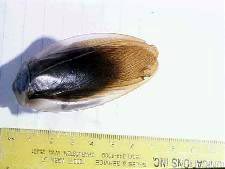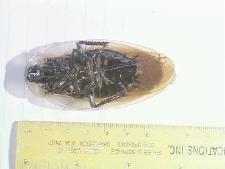
 |
Cockroaches make up the order Blattaria, also known as Blattodea. The American cockroach is classified as Periplaneta americana, the German cockroach as Blatella germanica, the Oriental cockroach as Blatta orientalis, the brown-banded cockroach as Supella supellectilium, and the Madeira cockroach as Leucophaea madera. The Asian species that appeared in Florida in the 1980's is classified as Blatella asahinai. |
 |
The cockroach is a common name for any of at least 3,500 known species of insects, including a few familiar as household pests. They are an ancient group, having slightly changed their appearance in 320 million years. Fossil records indicate that they were the predominant insect during the Carboniferous period, the "age of cockroaches." About 25 species have achieved worldwide distribution, a result of their propensity to live with people. An Asian species began to cause concern in the United States when it appeared in large numbers in florida in the late 1980's. Unlike the common German cockroach that everyone recognizes running into the corners when you turn on a light suddenly, the Asian species is attracted to light. |
A cockroach's life cycle is very unique. Courtship patterns vary with species. When the American cockroach is ready to mate, the female produces a chemical odor, or pheromone, that attracts the males. The males flap their wings back into things when they sense the pheromone and eventually back into a female, and mating is accomplished. Other species have more elaborate patterns which include hissing noises, bobbing and waving of the abdomen, or nibbling. The males of one African species form dominance heirarchies and the females preferentially mate with the dominant male.
Another variety with species of cockroaches is the respect in which they carry the eff case or ootheca. German cockroaches keep the ootheca extended from their ovipositor, depositing it only when the eggs are ready to hatch. The American cockroach quickly deposits the ootheca, hides it and leaves it to hatch. The ootheca contains from sixteen to thirty-two eggs, depending on species. Ootheca-incubating cockroaches appear to show some degree of maternal care; the nympths often remain around their mother for several days.
Cockroaches are an essential part of the ecosystem. They can eat a wide range of substances including other cockroaches and waste. Because of the variety of bacteria and protozoans in their gut, they play an important role in the rapid decomposition of forest litter and animal fecal matter. Cockroaches are then food for many animals, including some humans. Household cockroaches have been identified as disease carriers. The insects are also ideal laboratory animals, easy to care for and easy to handle because they do not sting or bite.
Due to the rapid breeding of cockroaches, the fact that they soil things, have a bad odor and are at least potential disease carriers, they are often attacked with insecticides. However, they have adapted to several of them and new types have had to be used. Attempts to use pheromones as sex lures or to sterilize male cockroaches have thus far not proved practical on a large scale. Two methods are currently used in houses. Sprinkling diatomaceous earth which they find irritating or use of boric acid powder which is poisonous both work to various degrees. However, even with our best efforts, cockroaches continue to thrive and florish and will be with us for a long, long time.